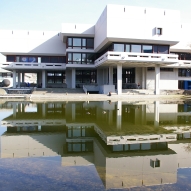Zusammenfassung
Aspartof a programme to develop fluorescence-based methods for the study of the interactions between G-protein coupled receptors (GPCRs) and their ligands the preparation of low molecular weight fluorescence-labelled neuropeptide Y (NPY)Y-5 antagonists is reported. The naphthylsulfonyl group in the potent quinazoline-type NPYY5 receptor antagonist CGP 71683A was replaced with a dansyl, ...
Zusammenfassung
Aspartof a programme to develop fluorescence-based methods for the study of the interactions between G-protein coupled receptors (GPCRs) and their ligands the preparation of low molecular weight fluorescence-labelled neuropeptide Y (NPY)Y-5 antagonists is reported. The naphthylsulfonyl group in the potent quinazoline-type NPYY5 receptor antagonist CGP 71683A was replaced with a dansyl, nitrobenzoxadiazole (NBD) or acridine-9-carbonyl group. In radioligand binding studies on human Y-5 receptor expressing HEC-1B cells the substances labelled with acridine (K-i 311 nM) and NBD (K-i > 1000 nM) proved to be moderately active or inactive, respectively By contrast, a K-i value of 49 nM was found for the dansyl analogue compared to 2 nM for CGP 71683A. No binding to Y-1 receptors (SK-N-MC cells, displacement of [H-3]propionyl-NPY) was detected for the new compounds at concentrations less than or equal to 1 muM.






 Altmetric
Altmetric